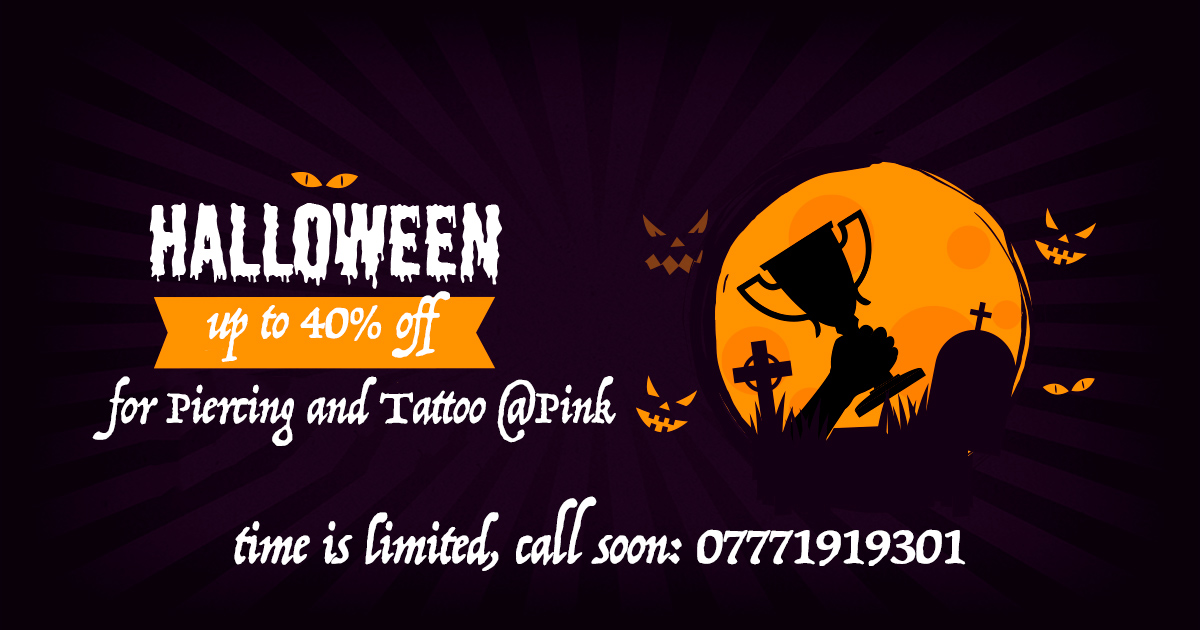Hidden beneath a cascade of hair, revealed only with an elegant updo or the turn of the head—the nape piercing is a statement of confident, subtle rebellion. Placed symmetrically on the back of the neck, its two glittering ends create a look that is both edgy and surprisingly elegant. It’s a piercing that is personal, often kept as a secret for the wearer to share at their discretion, making it a powerful and intimate form of body art.
However, the allure of this unique placement conceals a significant technical challenge. The nape piercing is a true surface piercing in one of the highest-movement areas of the body, and it carries a substantial risk of rejection if not performed with master-level skill.1 The choice of piercer and, critically, the choice of jewellery, are the absolute deciding factors between a beautiful, long-lasting piercing and a failed one that leaves a prominent scar.
At PinkTatPier, we are often the studio clients turn to after having a negative experience elsewhere. We recently had a consultation with a client, Sam, who came to us with an angry, red, and irritated scar on the back of his neck from a failed nape piercing performed at another studio. He was disheartened but still loved the look. Our lead specialist began by examining the old scar, explaining that it had been pierced with a curved barbell—the incorrect jewellery, which guarantees rejection. Our first step was not to re-pierce, but to provide Sam with a scar-care regimen to help the tissue recover. Months later, once the area was healthy and stable, we were able to start a new project. We showed Sam a proper, staple-shaped surface bar, explaining how its flat design works with the body, not against it. The new piercing we performed sat flush, flat, and calm against his skin, a stark contrast to his previous painful experience. This story is a testament to our core belief: that expertise and education are the foundation of every safe piercing.
This guide is an extension of that honest, expert-led experience. It is the definitive resource for anyone seriously considering a nape piercing London, designed to give you the unvarnished truth about the procedure, the critical importance of correct jewellery, and how to get a cost estimate for our professional service.
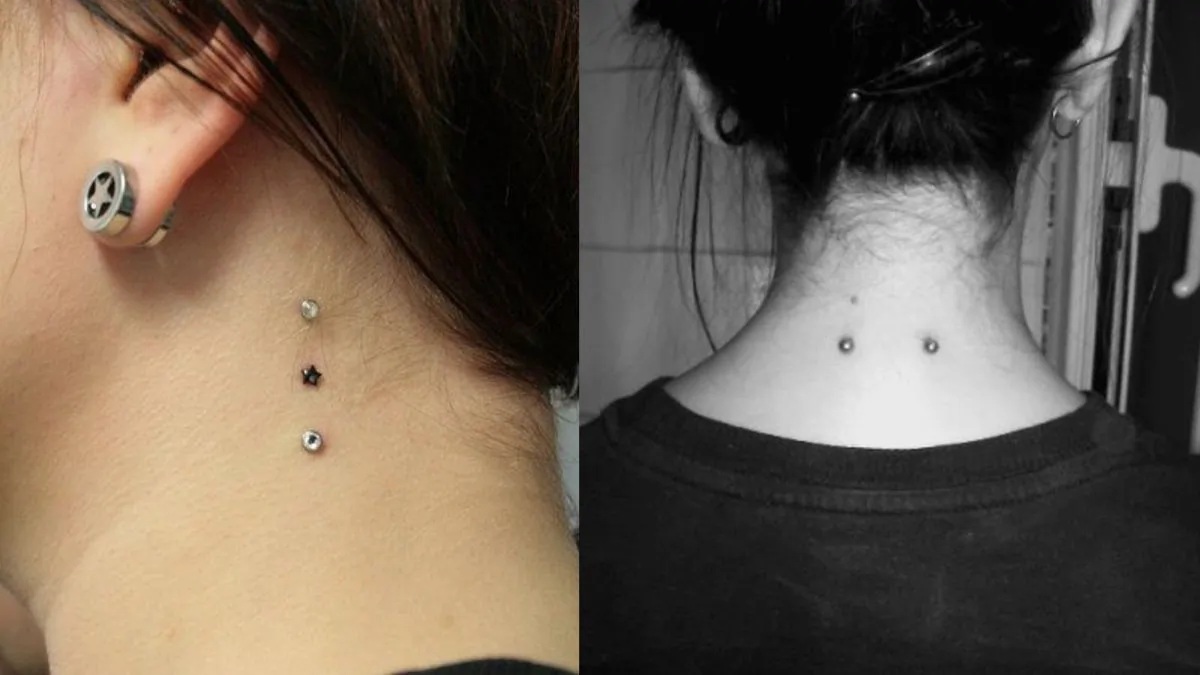
nape piercing
Understanding the Nape Piercing: A True Surface Piercing, Not a Dermal
To make an informed decision, you must first understand the mechanics of this piercing. It is fundamentally different from a standard ear or facial piercing.
The Definition: A Horizontal Bar Beneath the Skin
A nape piercing is a single piercing channel that runs horizontally under the surface of the skin at the back of the neck. It has two visible ends, typically adorned with simple beads or gems, creating the illusion of two separate piercings. In reality, these two ends are connected by a single, solid bar of jewellery that sits beneath the skin.
The Most Critical Factor: Jewellery Shape Dictates Success or Failure
This is the most important educational component of this entire guide, and the detail that separates a true professional from an amateur.
- The WRONG Jewellery (Curved Barbell): Many inexperienced piercers will attempt to perform a nape piercing with a long, curved barbell (like the type used for a navel piercing). This is guaranteed to fail. Imagine trying to hold a curved object flat under taught skin. The “C” shape of the barbell exerts constant, outward pressure on the entry and exit holes. Your body will identify this pressure as a threat and will begin the process of “pushing” the foreign object out. This leads to irritation, inflammation, migration (the piercing moving from its original spot), and eventual rejection, often leaving a significant scar.2
- The CORRECT Jewellery (Surface Bar): A true professional service for a nape piercing London will exclusively use a “surface bar.” This is a piece of jewellery shaped like a staple, with a flat bar that sits parallel under the skin and two 90-degree posts that rise up to the surface.3 This design sits neutrally within the tissue, eliminating the outward pressure and giving the body the best possible chance to heal around it. At PinkTatPier, we use only high-quality, implant-grade titanium surface bars, often custom-bent to perfectly match the contour of the client’s neck.
Nape Piercing vs. Dermal Anchors
It’s also possible to mimic the look of a nape piercing using two separate dermal anchors. While this is a viable option, a single surface bar often provides more stability in this high-movement area. During your consultation, our specialist can discuss the pros and cons of each method as they relate to your specific anatomy and lifestyle.
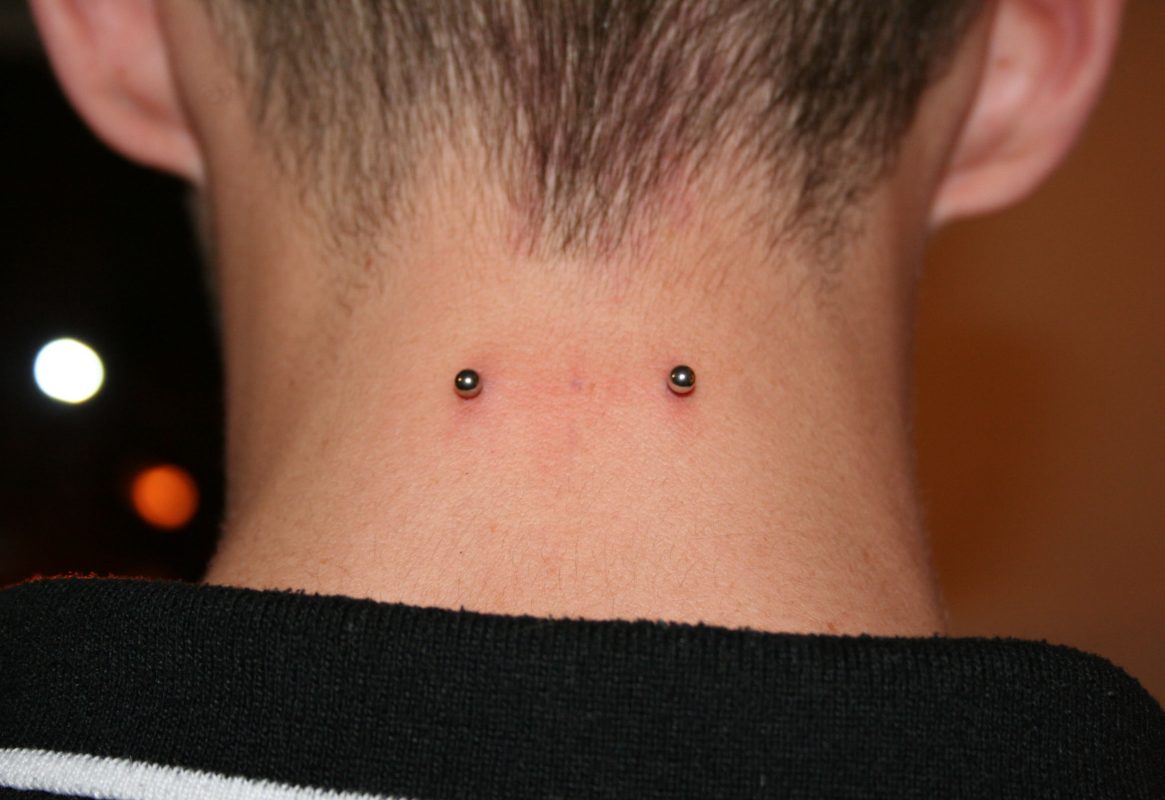
nape piercing
The High-Stakes Environment: Why the Nape is So Challenging
The back of the neck is one of the most difficult places on the body to heal a piercing. Its environment is in a constant state of flux, presenting several major challenges.
Constant, Unavoidable Movement
Think about how many times you move your head every day. Every nod, every turn to look over your shoulder, every time you bend down—all these actions cause the skin on the back of your neck to stretch, compress, and move. This constant motion puts significant stress on a healing piercing channel, disrupting the fragile new tissue and prolonging the healing process.
The Ultimate Snagging Hazard: Hair, Clothing, and Towels
This is the number one cause of failure for even a perfectly performed nape piercing.
- Hair: Long hair is the primary adversary. It can easily become wrapped around the jewellery ends, causing painful tugs that can lead to irritation, migration, or even the piercing being traumatically ripped out.
- Clothing: The collars of shirts, jackets, hoodies, and scarves constantly rub against the piercing, causing friction and irritation.
- Towels & Bedding: Drying your hair or rolling over in your sleep can lead to an accidental and painful snag.
Our Studio’s Philosophy on High-Risk Placements:
“A nape piercing lives in a veritable warzone of movement and friction. Its long-term success is a triumph of perfect technique over a hostile environment. Our job as specialists is to give that piercing the best possible fighting chance from day one. That means flawless placement in the ‘safe zone’ of least movement, using only a properly fitted surface bar to minimize tension, and having a very direct and honest conversation with the client about the significant lifestyle changes they must adopt during the healing period. A nape piercing London is a true partnership; we perform the perfect piercing, and the client must provide the perfect environment for it to heal.” – Our Lead Specialist at PinkTatPier
The PinkTatPier Procedure and The Long, Demanding Healing Journey
Our professional service is an end-to-end process, designed for maximum safety and the best possible outcome.
The Consultation and Precision Marking
Your journey begins with an in-depth consultation. We will assess the tissue on your nape, identifying the ideal horizontal placement that is both aesthetically pleasing and located in an area with slightly less skin movement. We will then use a sterile marker and callipers to meticulously mark the placement, ensuring it is perfectly level and centered.
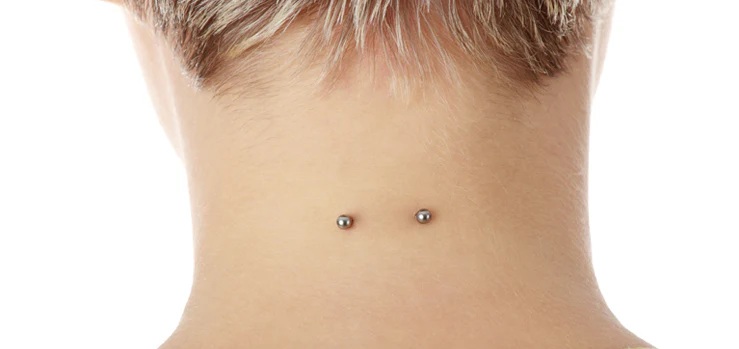
nape piercing
The Piercing Technique: Creating the Perfect Channel
A nape piercing is an advanced freehand technique. Your specialist will use a single-use needle to create a clean, precise channel at the exact depth required to accommodate the surface bar. The jewellery is then inserted in a smooth motion to minimise trauma. The entire procedure is performed with the highest standards of hygiene in our clinical-grade studio.
The Healing Timeline: A Marathon, Not a Sprint
Healing a nape piercing is a long-term commitment that requires immense patience and care. The timeline below is a realistic expectation.
Table: The Nape Piercing Healing & Aftercare Guide
| Timescale | What to Expect | Key Aftercare & Critical Warning Signs |
| Month 1-3 | Initial swelling, redness, and tenderness are normal. The area is extremely fragile and can be prone to minor bleeding if snagged. The ends of the jewellery will look “angry.” | Meticulous cleaning twice daily with sterile saline solution. You must keep your hair tied up and away from the piercing at all times. Be extremely cautious when dressing, showering, and sleeping (sleeping on your stomach or side is best). |
| Month 3-9 | The piercing will begin to stabilize and feel less tender, but the internal channel is still very much in the process of maturing. Irritation bumps are very common if the piercing is accidentally bumped or snagged. | Continue your vigilant aftercare routine. This is the period where complacency can lead to serious problems. Early Warning Signs: Look for the skin over the bar becoming red and thin, or redness that persists for days after a minor snag. |
| Month 9-12+ | The piercing may appear and feel fully healed. However, due to its location, it will always be considered a “high-maintenance” or “temperamental” piercing. | Clear Signs of Rejection: If you notice more of the barbell becoming visible through the skin over time, if the skin is persistently red, dry, or flaky, or if the piercing holes appear to be enlarging or “stretching,” contact us immediately. Early removal is key to minimising scarring. |
Cost & Consultation Process for a Nape Piercing in London
A nape piercing is an advanced procedure, and the price reflects the high level of skill and specialist jewellery required.
Why It’s a Specialist Investment
The cost of a nape piercing is higher than a standard piercing because it requires a longer appointment time for the meticulous marking and procedure, and it uses a specialised, high-quality implant-grade titanium surface bar, not a simple barbell.
How to Contact Us for a Nape Piercing Cost Quote
Due to the need to assess the area and potentially use custom-sized jewellery, the best way to get an accurate price is through a consultation. Your journey begins when you Contact Us.
- Request a Consultation: Contact our London studio via our online form or email to request a consultation for a nape piercing.
- In-Person Assessment: During your consultation, we will assess your anatomy, discuss the risks and your lifestyle, and answer all your questions.
- Receive Your Quote: We will then provide you with a precise, no-obligation cost quote for the full professional service, which includes the piercing, the surface bar, and our expert aftercare guidance.
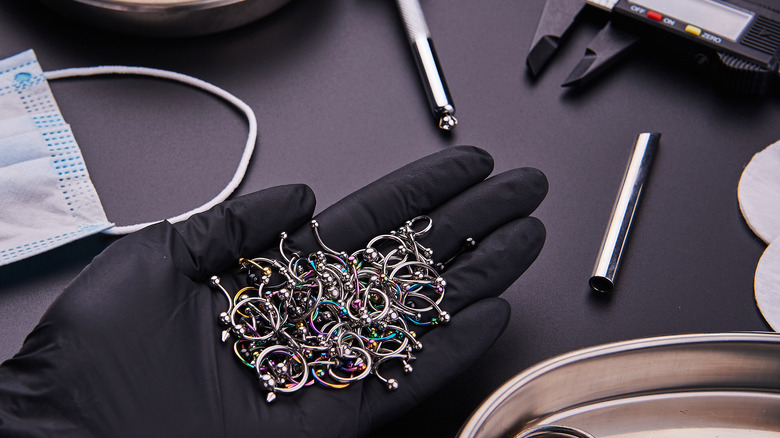
nape piercing
Frequently Asked Questions (FAQ)
1. Why did my last nape piercing (from another studio) reject?
While we can’t be certain without seeing it, the overwhelming reason for failed nape piercings is the use of incorrect jewellery. If your piercer used a curved or flexible barbell instead of a rigid, 90-degree surface bar, rejection was unfortunately inevitable.
2. How do I stop my long hair from getting caught in it?
During the entire healing process (up to a year), you must be extremely diligent. This means keeping your hair tied up in a high bun whenever possible, especially when sleeping. Using hair clips to keep stray hairs away is also essential. Braiding your hair can also help.
3. What is the difference between rejection and a simple irritation bump?
An irritation bump is typically a localised fluid-filled bump that appears next to one of the piercing holes, usually after a snag or period of pressure. It can often be resolved with improved aftercare. Rejection is a slower, more deliberate process where you will see the entire bar gradually becoming more visible under the skin as the body pushes it towards the surface.
Conclusion: A Piercing Where Expertise is Everything
The nape piercing is a stunning, high-impact piercing for the individual who understands and respects its unique challenges. It is a piercing where the difference between success and failure lies almost entirely in the hands of the piercer and their choice of jewellery. There is no “making do” with incorrect technique. By choosing a true specialist who uses the proper surface bar and possesses the skill to place it perfectly, you are making the only choice that offers a genuine chance of a beautiful, long-lasting piercing.
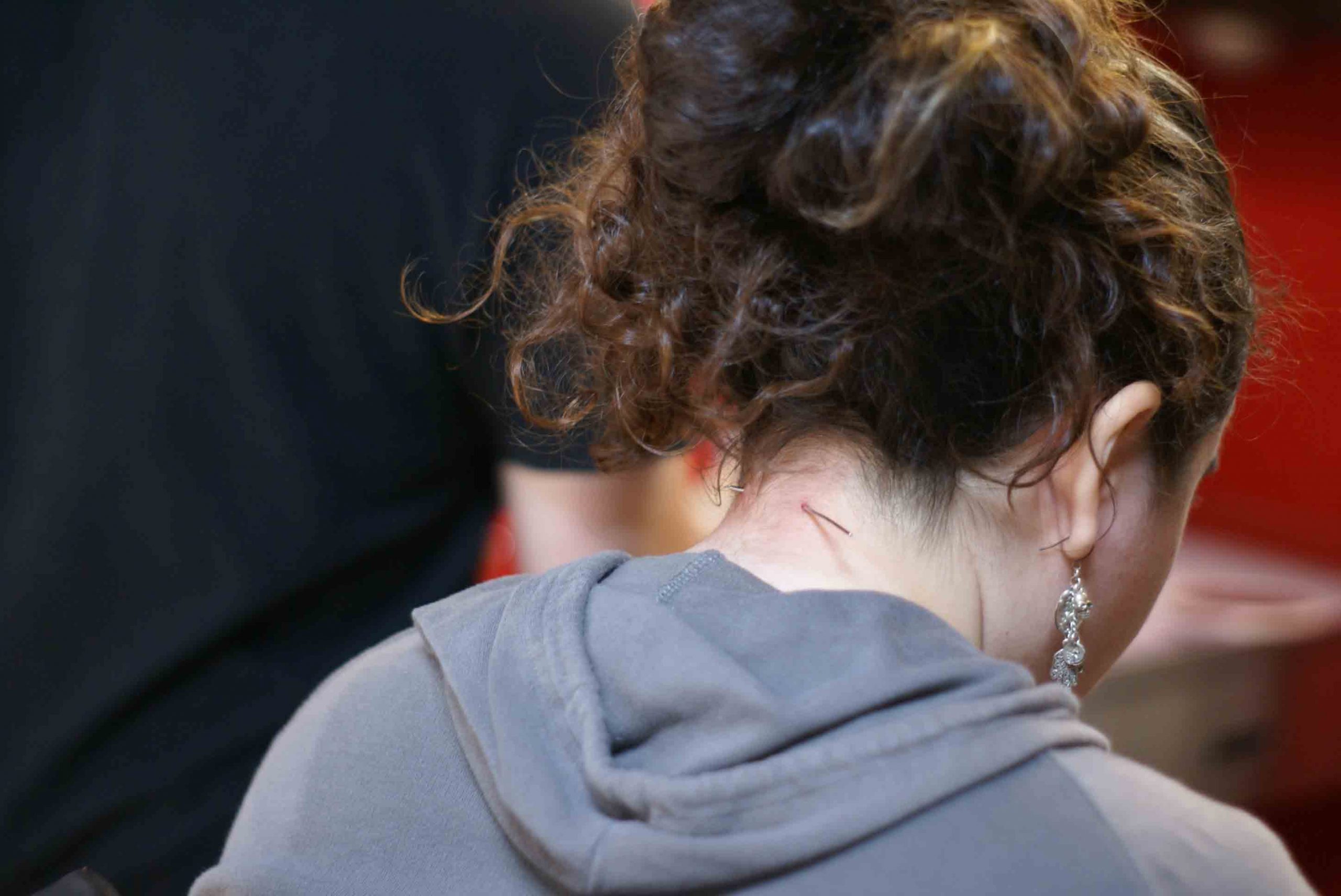
nape piercing
Your Next Step: Begin with an Expert Consultation
Don’t risk the health of your skin and a prominent scar on improper technique. If you are ready to commit to a beautiful, professionally executed nape piercing London, your first step is a conversation with an expert.
Contact Our London Studio today to schedule your in-depth consultation and receive a personalised cost quote for our professional service. Let us provide you with the honest, expert guidance this advanced piercing demands.

